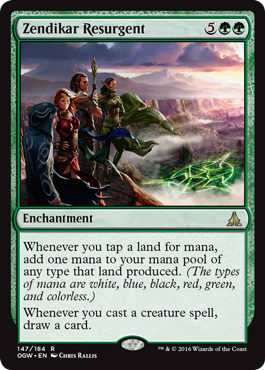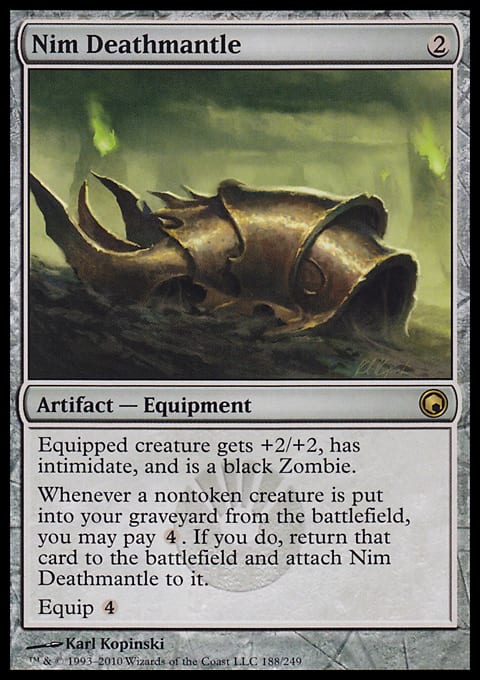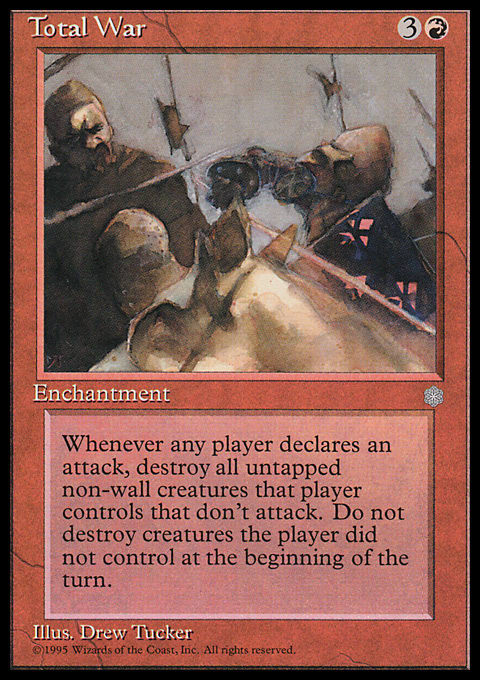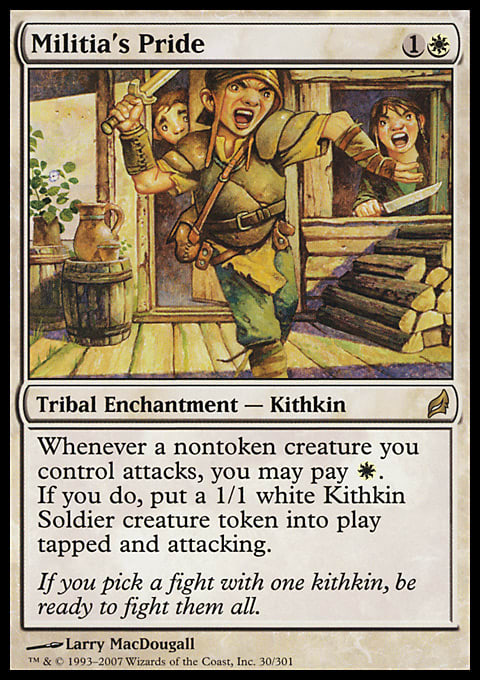Welcome back to Budget Commander Boot Camp, where we’ve been using Commander as the format to teach Magic: the Gathering. Abe Sargent and I have been your — ahem — drill sargents for this boot camp. To save time, we’re going to assume you’ve read the last four articles, introducing the decks and the concept. However, if you’ve been following along and just need a brief refresher, here it is:
- We’re building four decks, designed to play against one another, constructed of nothing but creatures and sorceries.
- The new player plays one of them and three other experienced mages use the other three, so the play is simplified and swingy. The point isn’t to build to power or teach deck-building, but to create a fun experience for the new player.
- Each deck will have a 20 card optionboard designed to introduce new card types as the new player gains experience.
- The total cost of all four decks will be $250 (minus basic lands), so it’s not completely out of reach and you could even give away one of them to someone who might make good use of it.
I’ve been using optionboards for a while in my Convertible Commander series, but for those of you who may not know, it’s a fairly simple idea. For a traditional commander deck, an optionboard is a small amount of cards carried with a deck which, when they’re swapped in, change the way the deck works in some way, small or large. In this situation, each optionboard will have six instants, six artifacts, six enchantments, and two Planeswalkers. After playing a few games with the new player with just sorceries and creatures, it might be time to introduce something new, so you pick the one you think the new player will like the most. Then everyone swaps in all of that type they have access to (in order to maximize exposure). If everyone puts six instants in each of their decks, you’re guaranteed to see at least a few of them over the course of a game. Planeswalkers will be a bit rarer, but at least one should show up over the course of a game.
You probably should not put the entire optionboard in at once. This game is complicated, and the most common reason someone doesn’t want to keep playing is because it’s overwhelming. Let them get a grasp of the decks with just two card types, then add in a single additional one to step it up. By working your way up to all four additional card types, the pieces will fall into place sensibly and without overloading the new player. They will need a brief explanation about when they can be played, and some explanation of how you cannot have two Sorins or two Jaces in play if they were in the optionboard of the new player, as you introduce each new type of card.
Remember, the goal here isn’t to make great decks, or even good ones. They’re supposed to be tuned to play against each other, not a table of regulars at your LGS, and they’re supposed to create a fun, splashy experience.
Our Temur Smash deck does exactly that — ramps and smashes. For a new player who’s enjoying playing giant creatures, let’s let them have some fun with that, while adding in some education about things like removal and card draw.
Temur Smash Optionboard ? Commander | Mark Wischkaemper
- Artifacts (6)
- 1 Bident of Thassa
- 1 Commander's Sphere
- 1 Darksteel Ingot
- 1 Lifecrafter's Bestiary
- 1 Loxodon Warhammer
- 1 Temur Banner
- Enchantments (6)
- 1 Berserkers' Onslaught
- 1 Elemental Bond
- 1 Fires of Yavimaya
- 1 Temur Ascendancy
- 1 Warstorm Surge
- 1 Zendikar Resurgent
- Instants (6)
- 1 Naturalize
- 1 Plasm Capture
- 1 Reality Shift
- 1 Sarkhan's Triumph
- 1 Stubborn Denial
- 1 Temur Charm
- Planeswalkers (2)
- 1 Kiora, the Crashing Wave
- 1 Sarkhan Unbroken
The artifacts add a good amount of additional mana, which teaches the value of colors versus colorless, as well as additional value from things like Commander's Sphere. We also get excellent card draw effects in Bident of Thassa and Lifecrafter's Bestiary, plus we can work on politics with Bident’s activated ability and remembering triggers with the Bestiary.
The enchantments are really fun. Berserkers' Onslaught — “my huge guys hit twice!?” We get haste, we get card draw, and we throw some damage around with Warstorm Surge. Zendikar Resurgent is expensive and splashy and shows the power of draw and extra mana to that level.
We continue to learn more ways the game works with the instants. Naturalize gives us the classic, well, Naturalize effect; Stubborn Denial and Plasm Capture are counterspells; Reality Shift is removal; Sarkhan's Triumph is a tutor. Temur Charm introduces choices, and it gives some good ones!
It’s hard to not get excited about Kiora, the Crashing Wave. More experienced players look to the first two abilities; new players look at the ultimate, and wow — what an ultimate! Sarkhan Unbroken is wonderfully on color, plus he once again shows the value of extra cards and mana and teases at another deck with his ultimate.
All told, this optionboard is $18.13, which means our total cost for this deck, with the optionboard, is $46.07 (unless, of course, a few of the cards have changed prices, which can happen between writing and publishing).
Our Obzedat, Ghost Council deck, on the other hand, is a bit more subtle. We’re gaining a ton of life and winning however we can, outlasting our opponents. Our optionboard reflects those characteristics.
Obzedat Optionboard ? Commander | Mark Wischkaemper
- Artifacts (6)
- 1 Aetherflux Reservoir
- 1 Elixir of Immortality
- 1 Orzhov Cluestone
- 1 Orzhov Keyrune
- 1 Orzhov Signet
- 1 Pristine Talisman
- Enchantments (6)
- 1 Blind Obedience
- 1 Consulate Crackdown
- 1 Hidden Stockpile
- 1 Palace Siege
- 1 Sanguine Bond
- 1 Test of Endurance
- Planeswalkers (2)
- 1 Sorin, Lord of Innistrad
- 1 Sorin, Solemn Visitor
Once again, our artifacts are mostly about mana. But Aetherflux Reservoir is exciting to think about, and Elixir of Immortality is right in this deck’s wheelhouse — gain life and reshuffle the ‘yard to continue to outlast.
The enchantments also give us more tools to survive the board state. Sanguine Bond is one half of the classic Exquisite Blood/Sanguine Bond combo, which isn’t included (mostly for price), but is still great by itself and a way to leverage our lifegain. Palace Siege gives us a good choice, and we can show how the obvious option (Dragons) isn’t always the best, because combined with Hidden Stockpile, we can turn fallen blockers into value, and Palace Siege set to Khans will then return the blocker to be cast again! Consulate Crackdown shuts down another player’s artifacts and demonstrates how devastating that could be. Finally, Test of Endurance is a straight-up win condition.
Removal is the name of the game for the instants. We’ve got lots of different types — tucking, exiling, destroying; creatures, enchantments, permanents. This is something ![]()
![]() does really well, so it’s worth it to show it. And Orzhov Charm, once again, gives us choices. Let the new player work out what to do with the card.
does really well, so it’s worth it to show it. And Orzhov Charm, once again, gives us choices. Let the new player work out what to do with the card.
And the vampire lord himself, Sorin, shows up in two iterations. Just as the deck is designed for the slightly more advanced gamer, Sorin is a bit more subtle. The ultimates may not be quite so huge, but we can make extra blockers and do fun things with lifelink, adding to the lifegain.
Mostly because of Test of Endurance, our total for this optionboard is $31.69, but the total for both is still only $56.09, which should leave Abe plenty of cash to do his thing. Speaking of which, take it away, Abe!
Thanks Mark!
All right, let’s look at the two Commander decks that I built.
The first is a graveyard infused Gisa and Geralf deck with all of the Zombie cards that you would expect to stop, drop and roll out of the graveyard or your hand in equal measure for Zombie loving. I included a smattering of simple self-milling options that would get you some additional graveyard options, as well as some flashing back.
While the graveyard strategy is certainly versatile and grindy, ready for the long game as well as fast out of the gate, but it lacks range and punch. The Zombies are, well, on the smaller side of life, and lots of Commander decks present issues that are hard to handle. Take the Temur SMASH deck above with its bigger creature base as one example, or a traditional ramp deck as another. Up until now, I only have a few Lords in here to pump up the Zombie team, so I want to add in resilience, and ways of attacking other people in Zombie friendly ways.
Zombie Chomp Optionboard ? Commander | Abe Sargent
- Artifacts (6)
- 1 Armillary Sphere
- 1 Altar of Dementia
- 1 Darksteel Ingot
- 1 Embalmer's Tools
- 1 Epitaph Golem
- 1 Nim Deathmantle
- Enchantments (6)
- 1 Call to the Grave
- 1 Endless Ranks of the Dead
- 1 Graf Harvest
- 1 Liliana's Mastery
- 1 Necromancer's Stockpile
- 1 Rooftop Storm
- Instants (6)
- 1 Compelling Deterrence
- 1 Cruel Revival
- 1 Feast or Famine
- 1 Feeding Frenzy
- 1 Forbidden Alchemy
- 1 Opportunity
- Planeswalkers (2)
- 1 Jace, Memory Adept
- 1 Jace, Architect of Thought
This optionboard clocks in at $27.40. The obvious Planeswalker is Liliana, Death's Majesty, but she is way out of the price range of our budget, but these Jaces give vital card drawing, milling, and ways to mess with our opponents. Jace is fine here!
Now I went in a similar direction as Mark and delved into artifacts to help mana, but I had fewer needs here as the initial deck was running a lot of on color lands, and so I just tossed in the Darksteel Ingot and Armillary Sphere, both of which are a cheap to acquire and have long game. The Sphere in particular is card advantage. And for a deck like this that may be playing a Zombie from the graveyard and other things as well, getting two lands from it is nice. I also tossed in a few more intentional cards to play on out theme, with the Epitaph Golem, Embalmer's Tools, and Nim Deathmantle all plating into obvious space. The Altar of Dementia can be a cool sacrifice outlet for something about to die, and can be turned on yourself or elsewhere, as the battlefield suggests.
Now every single enchantment is a Zombie themed on-support card. Many do exactly what you expect, like Graf Harvest and Necromancer's Stockpile to discard zombies to play them off Gisa and Geralf while also getting you a Zombie token. The best card here is likely Call to the Grave, the sort of card that unanswered can push a table around, especially given our Zombie theme. Although it can force you to kill Gisa and Geralf, so use it with care. Liliana's Mastery? Endless Ranks of the Dead? I think this enchantment suite is the best addition to the deck.
For my instants, I wanted both cards that were answers as well as played with the theme. Zombie themed instant removal includes Cruel Revival, Feeding Frenzy, and Feast or Famine, while we can draw cards and dig with the others and we have a surprise bounce spell to. It’s a good addition to the deck.
So with these 20 cards coming in at various times (and again, to echo Mark, make sure you aren’t tossing them all at once, ease them in) then you have various degrees of simplicity (Darksteel Ingot, Opportunity, Cruel Revival) and complexity (Altar of Dementia, Call to the Grave). Make those swaps as they are useful.
What about my other deck?
Now this deck is a little unusual. It’s Johan-led vigilance with exert creatures and combat triggers and cards that work well when they attack, or to tap the team after they swing. It includes cards like Relentless Assault, Combat Celebrant, Champion of Rhonas, and Pristine Angel. Lots of synergy, and all about swinging.
I wanted to push that hard here.
Johan Optionboard ? Commander | Abe Sargent
- Artifacts (6)
- 1 Bow of Nylea
- 1 Darksteel Ingot
- 1 Dolmen Gate
- 1 Gorgon Flail
- 1 Moonsilver Spear
- 1 Sword of the Animist
- Enchantments (6)
- 1 Brave the Sands
- 1 Gleam of Battle
- 1 Iroas, God of Victory
- 1 Militia's Pride
- 1 Always Watching
- 1 Total War
- Instants (6)
- 1 Beast Within
- 1 Boros Charm
- 1 Hold the Line
- 1 Melee
- 1 Order // Chaos
- 1 Sprout Swarm
- Planeswalkers (2)
- 1 Domri Rade
- 1 Ajani, Caller of the Pride
We clocked in at $35.24 for the Johan optionboard.
Let’s start with the obvious. Ajani, Caller of the Pride, was my first choice for this deck, and luckily, he was cheap. He is, to my mind, the single best ‘walker for the deck — cheap, can give double strike which plays havoc with the team, and his counter-age is great in the early game to help build up a powerful army. He starts with 4 loyalty for a 3-drop, and can be at 5 by the time you use him on the 5th turn. My 2nd favorite option was way too pricey (Elspeth, Knight-Errant), but that’s okay, because Domri Rade was my 3rd choice, and is very strong here. Domri plays well with decks that run a lot of creatures. Like the Caller of the Pride iteration of Ajani, Domri is also a 3-drop, can get you card advantage or to fight off potential defenders. And the Fight ability works well with the smattering of deathtouch I have in the deck already in the first run, like Nightshade Peddler.
Now the most confusing card and powerful card in this entry is Total War, so you will need to unpack it. Most people either forgot what it does or never knew. So, we’ll delve into it.
Here’s the current Oracle text:
When this enchantment is out, if anyone attacks with a creature, they have to attack with all of their non-Walls that didn’t come into the battlefield before they attacked, or they lose those creatures. What this does is it shuts down the lonely attacker. The flyer. The creature with shadow. The creature that entered a Rogue's Passage. The big giant creature that can get through, and so forth. You cannot leave blockers to hold the fort. The only typical blockers left will be creatures played after an attack, Walls, and creatures with vigilance that attacked that are still untapped. Note that this still works just on Walls, and non-Walls with defender will die under a Total War.
What does this mean for your Johan deck? It’s virtually perfect here. (Just watch for Johan. If Johan swings, your team loses vigilance, although I’ve included some non-Johan ways to add in vigilance.) Imagine someone who would normally come your way with the one or two creatures that can slip around your en-vigilanced defender. They aren’t coming your way now, because they’d have to bring the team, and you have a bunch of blockers to mess with them. They are more likely to attack each other, and when they do, it will have to swing all out, which plays into your vigilance plans to lean on them hard. Your deck wanted to attack each turn anyway with all of its creatures, so Total War is fine for you.
Two of the other new enchantments are attack triggers, Militia's Pride and Gleam of Battle that will make more troops and bigger effects when you swing. Always Watching is a bit pricey these days, but I used the budget Mark came under to make it work. Brave the Sands? That works too!Brave the Sands gives you vigilance and plays well in case someone kills your Johan or he hasn’t arrived yet. See how cards like Brave the Sands love Total War?
But Iroas, God of Victory is king here. I wanted effects that would keep your team from dying in combat. You should be able to swing with impunity. Iroas plays into that space, as does artifact Dolmen Gate. I mentioned how good deathtouch is here swinging with your whole team, setting up dangerously bad blocks. How could I not run Bow of Nylea? And you can use it for counters or other various effects as well as needed. See also — Gorgon Flail. And we get another pair of attack triggers with Moonsilver Spear and Sword of the Animist. Attack away!
Speaking of surviving an attack, I’m sure you can see the value of Boros Charm here and removal like Beast Within. Check out Order // Chaos as a fun way to either get in a free hit or to exile an attacking creature. Sprout Swarm does great work with your team. Play it with convoke and buyback at the end of someone’s turn and tap down your team to play a few Saproling tokens, and then untap and get your swing on. (Note that the exert creatures should not be tapped down with Sprout Swarm if they used exert, as they won’t untap).
I love Hold the Line as a fun surprise instant with the smaller creature vigilance base we had! If someone swings with their team (maybe invited by Total War) you can turn the tables instantly, literally, by dropping Hold the Line. You shall not pass!
Now we have one more janky old school card here
Oracle:
You choose which creatures block this combat and how those creatures block.
Whenever a creature attacks and isn't blocked this combat, untap it and remove it from combat.
Check this total surprise. Swing at someone with all of your creatures. All of them. (Except for maybe Johan). Note that swinging with the team will still net all of those tasty attack triggers including the exerts. Yay for you! Now cast Melee before they block. And you can use this to force how your foe blocks, so you can set up some seriously unfortunate blocks by your foe to kill some creatures. Then you get to untap the ones that were unblocked and pull them from combat, in case you haven’t gotten Johan yet and wanted to reset some creatures for blocking. It’s a great flavorful addition to the Johan deck!
I almost put in Stitcher's Graft, Captain's Claws, and Mage-Ring Responder. What would you have thought of those?
And that’s a quartet of deck-optioning!
Our total cost for the optionboards?
$112.46
Initial cost of the four decks? $119.21
So our total cost for the project was $231.67, or almost twenty dollars shy of our budget of $250. You can purchase decks and cards like this on all sorts of budget friendly options.
I hope that you enjoyed our trek through the fours decks and where they are going next! It’s important to remember basics, key cards, and more when you add to a deck that already works, right?
Where is the project at now?
Well, Mark and I wrote this series, and initially we each created two Commander decks with just creatures, lands, and sorceries to help teach newer players how to play. We talked about how to enjoy it! Have fun with it! Don’t try to win, let them play at their own pace, answer their questions, and keep from breaking the deck you are given. And now we’ve built the 20 card options for each of these decks.
These decks are designed to be disposable. We have most of these cards laying around, and those we don’t are cheap or easily replaceable with cards you own.
But Magic is ultimately about playing the game. Therefore, the goal is to have both of us run these decks in real life, and then bring you those results for the 6th and (likely) final iteration of this series. And we can look at what worked, what didn’t, and what the results were!
Sound like a plan?
All right then. Game on; this Boot Camp is about to take flight!




























